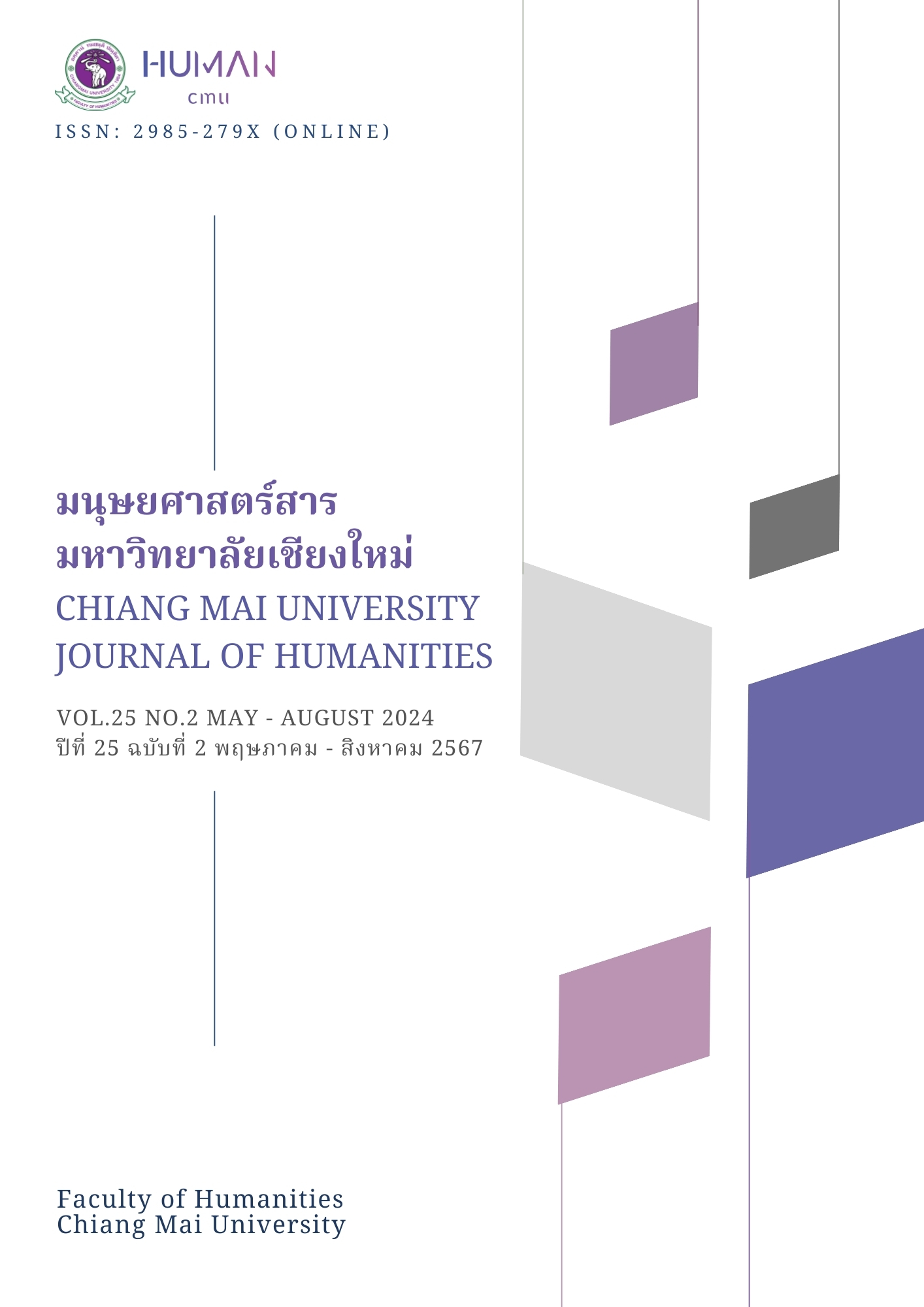ตัวตน ความเป็นคน และที่พึ่งพิงสุดท้ายของคนชายขอบ ในวรรณกรรมเรื่อง หมา ของปาจิน
Main Article Content
บทคัดย่อ
“ฉันไม่ใช่คนหรอก เป็นแค่สิ่งของจำพวกเดียวกับ ‘หมา’ นั่นเอง” คำว่า “หมา” มิเพียงถูกใช้นิยามสัตว์ชนิดหนึ่ง หากแต่ยังเป็นการกล่าวถึงนิยามตัวตนของตัวละครหลักในวรรณกรรมเรื่อง หมา ของปาจิน บทความนี้มุ่งศึกษาและนำเสนอตัวตน ศักดิ์ศรีความเป็นมนุษย์ สิทธิ และสิ่งศักด์สิทธิ์อันเป็นที่พึ่งพิงของคนชายขอบผ่านมุมมองของตัวละครหลักที่เป็นเด็กกำพร้าในวรรณกรรมเรื่อง หมา ของปาจิน โดยศึกษาและวิเคราะห์ผ่านแว่นแนวคิดจิตวิทยาเกี่ยวกับตัวตน ลำดับขั้นความต้องการของมนุษย์ ตลอดจนกรอบแห่งสิทธิมนุษยชนและศักดิ์ศรีความเป็นมนุษย์ ผลการศึกษาชี้ให้เห็นว่า ตัวตนของตัวละครหลักที่มีสถานะเป็นคนชายขอบในสังคมถูกบิดเบือนและลดทอนคุณค่า เหลือเพียงตัวตนของ “หมา” มิใช่มนุษย์ นำไปสู่การไม่สามารถรักษาศักดิ์ศรีความเป็นมนุษย์และสิทธิแห่งตนไว้ได้ เมื่อเป็นบุคคลที่ถูกผลักออกจากพื้นที่สังคม ที่พึ่งพิงเพียงหนึ่งเดียวจึงเหลือเพียงสิ่งศักดิ์สิทธิ์ที่ไม่กีดกันตัวละครหลักออกไป ความสัมพันธ์ระหว่างสิ่งศักดิ์สิทธิ์กับตัวละครหลักผู้เป็นบุคคลชายขอบจึงเกี่ยวข้องกันอย่างมีนัยสำคัญ ทั้งนี้ยังชี้ให้เห็นว่าปัจจัยการเปลี่ยนแปลงทางสังคมและทัศนคติของคนในสังคมล้วนส่งผลต่อการใช้ชีวิตของบุคคลหนึ่งๆ ดังนั้นวรรณกรรมเรื่อง หมา จึงเปรียบเสมือนบันทึกและกระจกที่สะท้อนอีกมิติหนึ่งของสังคมในมุมมองของคนชายขอบที่ตัวตนกลายเป็นเพียง “หมา” ตัวหนึ่ง
Article Details

อนุญาตภายใต้เงื่อนไข Creative Commons Attribution-NonCommercial-NoDerivatives 4.0 International License.
เอกสารอ้างอิง
กู๊ดริช, เค. (2553). A Short History of the Chinese People [ประวัติศาสตร์จีน] (พิมพ์ครั้งที่ 8). เคล็ดไทย.
จันทร์ฉาย ภัคอธิคม. (2553). ประวัติศาสตร์จักรวรรดิจีน. มหาวิทยาลัยรามคำแหง.
จันทิมา อังคพณิชกิจ. (2557). การวิเคราะห์ข้อความ. มหาวิทยาลัยธรรมศาสตร์.
จิราภรณ์ ตั้งกิตติภาภรณ์. (2556). จิตวิทยาทั่วไป. จุฬาลงกรณ์มหาวิทยาลัย.
ชฎารัตน์ สุนทรธรร. (2559). ศักดิ์ศรีความเป็นมนุษย์ของคนชายขอบ : ภาพสะท้อนจิตวิญญาณประชาธิปไตยใน
เรื่องสั้น. วารสารมนุษยศาสตร์และสังคมศาสตร์ มหาวิทยาลัยราชภัฏสุราษฎร์ธานี, 8(1), 153-180.
https://e-journal.sru.ac.th/index.php/jhsc/article/view/386
เทพรัตนราชสุดาฯ สยามบรมราชกุมารี, สมเด็จพระ. (2558). เพียงวันพบวันนี้ที่สำคัญ (พิมพ์ครั้งที่ 15).
นานมีบุ๊คส์.
ธันย์นิชา วิโรจน์รุจน์. (2563). ความมั่นคงทางจิตใจ: ลดความเสี่ยงช่วยแก้ปัญหาสังคม. วารสารมหาจุฬาวิชาการ,
(2), 141-150. https://so04.tci-thaijo.org/index.php/JMA/article/download/162970/118456/
นพมาศ อุ้งพระ. (2546). ทฤษฎีบุคลิกภาพและการปรับตัว (พิมพ์ครั้งที่ 3). มหาวิทยาลัยธรรมศาสตร์.
ปาจิน. (2562). หมา. ใน ปกรณ์ ลิมปนุสรณ์ (บ.ก.), เกิดใหม่ในกองเพลิง (น. 166-178). มติชน.
ยศ สันตสมบัติ. (2559). ฟรอยด์และพัฒนาการของจิตวิเคราะห์: จากความฝันสู่ทฤษฎีสังคม (พิมพ์ครั้งที่ 5).
มหาวิทยาลัยธรรมศาสตร์.
ราชบัณฑิตยสถาน. (2556). พจนานุกรม ฉบับราชบัณฑิตยสถาน พ.ศ. 2554. ศิริวัฒนาอินเตอร์พริ้นท์ จำกัด
(มหาชน).
ศรีเรือน แก้วกังวาน. (2548). ทฤษฎีจิตวิทยาบุคลิกภาพ (พิมพ์ครั้งที่ 12). หมอชาวบ้าน.
สำนักงานราชบัณฑิตยสภา. (2550, ธันวาคม 23). คนชายขอบ. http://legacy.orst.go.th/? knowledges=
คนชายขอบ-๒๓-ธันวาคม-๒๕๕๐
หลู่ซิ่น. (2551). ประวัติจริงของอา Q (พิมพ์ครั้งที่ 2). แม่คำผาง.
หลู่ซวิ่น. (2546). ข่งอี๋จี่. ใน ปกรณ์ ลิมปนุสรณ์ (บ.ก.), เรื่องสั้นของหลู่ซวิ่น (น. 55-62 ). ชุมศิลป์ธรรมดา.
Zalta, E. N. & Nodelman, U. (2022, September 3). Religion and Science. Standford Encyclopedia
of Philosophy. https://plato.stanford.edu/entries/religion-science/
巴金. (2022, November 4). 狗. 可可诗词. https://www.kekeshici.com/xiaoshuo/ mingpian/
html
孙靖琪. (2020, November 12). 巴金的抗战文学. 团结网. http://www.tuanjiewang. cn/
-11/12/content_8895082.htm


